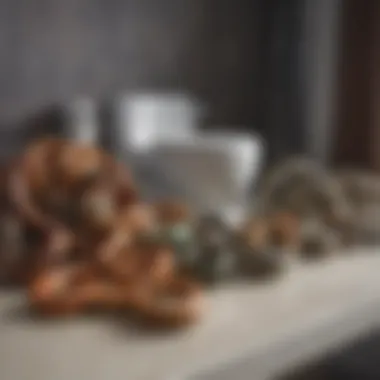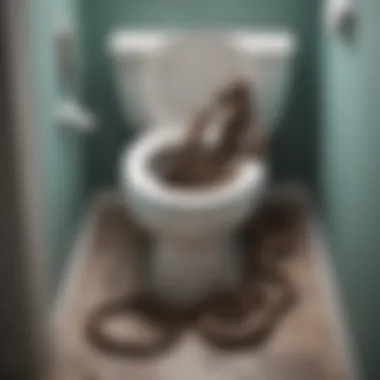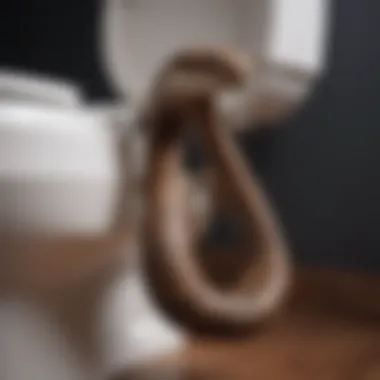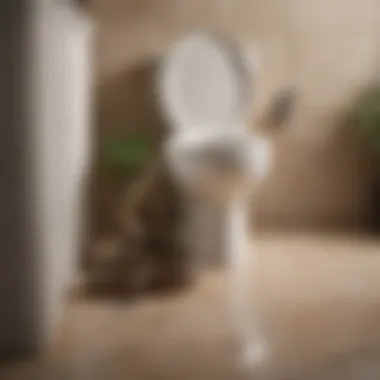Mastering the Toilet Snake: A Comprehensive Guide


Intro
Understanding the intricacies of plumbing at home can sometimes be overwhelming, especially when dealing with a clogged toilet. A toilet snake, or auger, serves as an essential tool for homeowners and DIY enthusiasts alike, providing an effective way to tackle such issues without professional help. This guide will explore the effective use of a toilet snake, diving into its types, applications, and techniques. With the right knowledge, individuals can master this tool and enhance their plumbing skills.
Toilets are one of the most frequently used fixtures in any household. They are vital for comfort and hygiene. Therefore, a clear understanding of how to address clogs can prevent inconvenience and maintain a smooth-functioning home. The following sections will unfold essential insights regarding the correct use of a toilet snake, emphasizing the importance of knowing its capabilities. This knowledge can empower individuals to resolve common plumbing predicaments independently.
There is much to learn about the proper techniques, types of toilet snakes, and other best practices that enhance the unclogging process. Being equipped with the necessary tools and understanding the procedures can save both time and money, making it a significant life skill.
By reading this guide, you will gain a comprehensive understanding of the toilet snake, elevating your home maintenance skills and ensuring effective problem-solving capabilities for plumbing issues.
Understanding the Toilet Snake
Understanding the toilet snake is pivotal for homeowners and individuals interested in DIY plumbing solutions. This section delves into both the technical and practical aspects of the toilet snake, revealing its significance in resolving some common plumbing hurdles. By grasping the fundamentals of what a toilet snake is and the problems it is designed to solve, one is better equipped to tackle clogs efficiently and prevent the need for costly professional services.
Definition and Purpose
A toilet snake, often referred as a toilet auger, is a plumbing tool designed explicitly for clearing blockages in toilet bowls. It consists of a long flexible cable with a coiled end that can navigate the curves of the toilet's trap. The primary purpose of a toilet snake is to dislodge and remove clogs that standard plungers cannot resolve. Its ability to reach deeper into the pipe can make a significant difference, especially when dealing with stubborn blockages.
Using a toilet snake properly can save time and mitigate frustrations that arise from plumbing issues. Its efficient design allows homeowners to avoid immediate reliance on professionals, reinforcing one's capability to manage their home maintenance. Suitable knowledge of its function can minimize damage and preserve the plumbing system as a whole.
Common Issues Addressed
Toilet snakes address several plumbing problems that can arise in daily home usage. Common issues include:
- Clogs from Foreign Objects: Toys, sanitary products, or excessive toilet paper may cause blockages that require removal.
- Build-Up of Waste: Over time, mineral deposits and organic matter can accumulate, leading to serious clogs.
- Misaligned Pipes: Occasionally, structural issues in the plumbing can cause persistent problems requiring a thoughtful approach to unclogging.
A toilet snake provides a handy solution for various scenarios, enabling homeowners to take direct action against plumbing woes.
By understanding the elements of the toilet snake and the issues it can resolve, individuals set a foundation for effectively maintaining their plumbing systems. The knowledge empowers proactive cleanup and the preservation of functionality in their homes.
Types of Toilet Snakes
Understanding the different types of toilet snakes is crucial for efficient use and effective problem-solving in plumbing situations. Each type has its own unique properties, advantages, and suitable contexts for use. Knowing these factors can enhance the unclogging experience and lead to better maintenance of your plumbing system. Selecting the right snake for your needs means that homeowners can tackle clogs with more confidence and effectiveness.
Manual vs. Electric Snakes
Manual toilet snakes are typically hand-operated tools designed for straightforward clogs. They are often favored for their simplicity and lower cost. The direct engagement provides users with control over the tool, allowing them to feel when they have successfully penetrated a blockage. Moreover, they require no electricity and thus can be utilized in various situations without dependence on power sources.
In contrast, electric snakes offer significant power and ease of use, especially for more stubborn clogs. They tend to include a motor that drives the cable forward, making it easier to deal with tougher blockages. This can be particularly useful for larger clogs or drain lines in older plumbing systems. The downside is that they need a power source and are generally more expensive. It's important to consider both the nature of the clog and personal comfort levels when choosing between these options.
Flexible vs. Rigid Snakes
Flexible snakes are ideal for navigating the twists and turns of toilet plumbing. Their ability to bend makes them suitable for tackling clogs that are not straight down the drain. They can absorb various angles in the pipes, making them versatile for different pipe configurations. However, flexibility can also compromise strength in some cases, so they may struggle with extremely tough or large clogs.


On the other hand, rigid snakes are constructed for maximum strength and efficiency in straight drains. They are less adept at maneuvering around obstacles, but their durability means that they can exert more force when dealing with formidable blockages. Users should assess their plumbing needs and clog conditions to ascertain the right choice between flexible and rigid options.
Best Brands and Models
When selecting a toilet snake, certain brands stand out for their reliability and performance. Notable brands include Roto-Rooter, Ridgid, and BrassCraft. Each of these manufacturers offers a range of models tailored for various plumbing issues. Products like the Roto-Rooter 75-Foot Drain Auger and the Ridgid FlexShaft model are well-regarded for their effectiveness and build quality.
In evaluating models, consider factors such as cable length, diameter, and user reviews. The right model often depends on the specific plumbing system and the common types of clogs encountered. Taking the time to research and read user feedback can significantly improve the likelihood of a successful unclogging experience.
Choosing the suitable toilet snake can make a significant difference in your ability to manage plumbing issues independently. Factors such as power source, flexibility, and brand reputation play key roles in this decision.
Preparing to Use a Toilet Snake
Preparing to use a toilet snake is critical for a successful unclogging experience. This preparation involves several factors that help ensure the task is performed efficiently and effectively. Understanding how to get ready not only saves time but also minimizes frustration during the actual unclogging process. Moreover, having the right tools and taking necessary safety precautions can prevent accidents and damage to both yourself and the plumbing system.
Gathering Necessary Tools
Before you begin using a toilet snake, gathering the necessary tools is essential. The basic tools for this task include:
- Toilet snake: Choose a manual or electric snake based on your preference and clog severity.
- Rubber gloves: Protect your hands from germs and chemicals.
- Bucket: This is for any overflow that may occur during the process.
- Towel or rags: Useful for cleaning up spills or messes.
- Flashlight: This will help illuminate the toilet bowl and pipes as you work.
Having these tools ready before you start will make the process smoother. Each item has a specific purpose and omission can lead to complications. For instance, without gloves, you might expose yourself to unsanitary conditions.
Safety Precautions
Safety is paramount when using a toilet snake. Here are several vital precautions to keep in mind:
- Wear protective gear: Always put on rubber gloves. This protects your skin from bacteria and potential chemical residues.
- Turn off water supply: Before starting, turn off the water supply to the toilet to avoid accidental overflow.
- Avoid using harsh chemicals: If there are any drain cleaners in the toilet, do not combine them with a snake. This can lead to dangerous reactions.
- Use tools properly: Make sure you understand how to operate the snake before inserting it into the toilet. Improper use can cause breakage or injury.
- Be cautious of jerking motions: When working with the snake, avoid sudden or forceful movements. This reduces risk of damaging pipes or the toilet itself.
By implementing these precautions, you not only protect yourself but also ensure the longevity and functionality of your plumbing system. Proper preparation before using a toilet snake goes a long way in achieving success.
Using a Toilet Snake: Step-by-Step Guide
Utilizing a toilet snake effectively is essential for every homeowner. It allows you to address clogs promptly without relying on outside help. This section will help you understand the process clearly, from identifying the clog to proper cleaning methods after usage. Knowing how to use a toilet snake will not only save you time but will also save money on plumbing bills.
Identifying the Clog
Before you begin, it is important to assess where the blockage is located. Common signs include slow draining or backing up. The type of clog can dictate your approach. For instance, solid objects may require special attention compared to a simple waste accumulation. Take a moment to observe the toilet’s behavior. If unusual sounds occur, or if water levels fluctuate, these are good indicators of a clogged drain.
Inserting the Toilet Snake
Once you have identified the clog, proceed to insert the toilet snake. Start by removing the lid from the toilet tank and placing it in a safe location. Then, carefully introduce the snake into the bowl. Angle it downwards as you push through the water. Make sure to keep a firm grip on the handle while you feed the snake into the drain. If the clog is severe, you may have to apply a bit of force. Ensure the snake goes beyond the trap; this is where most clogs happen.
Navigating the Trap and Drain
As you navigate the trap, it’s vital to understand its structure. The trap is a bend in the plumbing designed to keep sewer gases from entering your home. Gently maneuver the snake through this area. If you feel resistance, do not force it. Instead, twist the snake a little to break through the clog. You’ll notice a change in resistance once you pass the blockage, which indicates you are on the right path. This step often requires patience, but it's crucial for effective unclogging.


Removing the Clog
Once you feel that the snake has successfully navigated through the obstruction, it is time to remove the clog. Pull the snake back slightly and rotate it in a circular motion. This action helps to break apart the blockage. Once the resistance eases, pull the snake out carefully. You should bring out debris along with it. This may include toilet paper, small objects, or other waste material. Ensure that you dispose of this material properly.
Cleaning the Snake After Use
Proper maintenance of your toilet snake ensures its longevity and performance. After you have finished unclogging, rinse the snake thoroughly with clean water. This will help remove any residue. If necessary, you can use a mild detergent. Once cleaned, dry it completely before storing it away. Storing a wet or damp snake can lead to rust and deterioration, reducing its effectiveness in the future.
Cleaning your toilet snake can prolong its life and protect your plumbing system from contamination.
With this knowledge, you are now equipped to use a toilet snake effectively. The steps outlined will guide you through the process of unclogging and keeping your equipment in good condition.
Troubleshooting Common Issues
When using a toilet snake, various challenges may occur. Understanding these problems and their solutions can save time, money, and effort. This section focuses on the most common issues that may arise and offers practical strategies for resolving them. This knowledge empowers homeowners and DIY enthusiasts to handle plumbing problems effectively.
When the Clog Persists
Even after using a toilet snake, it is possible for a clog to remain. If this happens, several factors may contribute to the persistence of the blockages. One key issue could be the type of clog. For example, hard objects like toys or sanitary products cannot be removed with a snake. In such cases, attempting to dislodge the object may push it further down the pipe.
Another consideration is the depth of the clog. Some blockages are not accessible through the toilet opening because they are located deeper in the plumbing system. If the toilet snake does not reach the clog, it may be necessary to use a different approach. A drain auger or water jet could be more effective for deeper, stubborn clogs, as these tools offer different methods for clearing blockages.
Here are a few steps to take when faced with a persistent clog:
- Reassess the Situation: Determine if the clog is truly unmovable.
- Check for Additional Blockages: Inspect other plumbing fixtures in the house as they could be connected.
- Consider Alternative Tools: If a toilet snake fails, a professional plumber might have specialized tools.
- Limit Flushes: Avoid flushing the toilet multiple times as it could lead to overflow.
"Sometimes, a different approach is needed when traditional methods do not work."
When to Call a Professional
There are times when calling a professional plumber is the most prudent course of action. If the issues persist despite multiple attempts to clear the clog, it may indicate a more serious underlying problem. Here are some signs that professional help is required:
- Repeated Blockages: If a clog returns frequently, it might signal tree roots in the sewer line or other issues.
- Persistent Odors: Unpleasant odors can indicate deeper plumbing problems related to waste or sewage.
- Gurgling Sounds: Strange noises from the toilet or other drains may signal improper venting.
- Physical Damage: Signs like water leaks around the base of the toilet or discoloration on walls indicate severe plumbing problems.
- Lack of Time or Resources: If the task appears too complex or time-consuming, it might be more efficient to seek professional services.
When reaching out to a plumber, be prepared to explain the symptoms and any actions you have taken. Good communication can help the plumber quickly diagnose the issue and recommend the best solution.
In summary, understanding persistent clogs and recognizing when to call a professional can prevent further complications. Knowing the limits of what a toilet snake can do equips homeowners with the necessary insight to navigate plumbing challenges.
Maintaining Your Toilet for Optimal Function
To ensure the longevity and proper functionality of your toilet, maintaining it is crucial. Regular maintenance can help avoid major plumbing issues, enhance hygiene, and conserve water. Factors in your toilet's environment and usage can lead to clogs, leaks, and wear over time. Understanding how to maintain your toilet effectively allows homeowners to address minor issues proactively, preventing them from escalating.
Regular Inspection Techniques


Periodic inspection of your toilet is essential. Here are some techniques to implement:
- Visual Checks: Look for cracks in the porcelain or signs of water pooling around the base. Small leaks can often go unnoticed until they lead to more significant problems.
- Flush Tests: Pay attention to how your toilet flushes. A weak flush may indicate a partial clog or an issue with the flushing mechanism.
- Water Level: Check the water level in the tank. It should be at the manufacturer's recommended height; this affects flush efficiency.
- Listen for Noises: Pay attention to unusual sounds, like hissing or gurgling. These can indicate problems with the water supply line or a clog drawing air in the drainage system.
These inspections serve not just to identify immediate issues but also to foster awareness of your toilet's overall condition.
Preventative Measures for Clogs
Preventing clogs requires a combination of practices that homeowners should adopt. Here are some measures:
- Flush Only Waste and Paper: Avoid flushing items such as wipes, feminine products, or excessive toilet paper. These can contribute to blockages in the toilet trap.
- Routine Maintenance: Use a toilet snake regularly to help clear any build-up before it becomes a serious clog. This helps to keep your pipes clear and less prone to issues.
- Install a Screen: If your toilet allows, consider installing a drain screen to capture debris that might otherwise proceed down the drain and cause a clog later on.
- Mind the Plumbing System: Understand how your household’s plumbing works. Older pipes may be more prone to clogs, necessitating careful handling of what goes into the toilet.
Following these steps can imprve your toilet’s efficiency, helping it serve its purpose effectively without interruptions. Regular checks and preventative measures truly empower homeowners to maintain an optimal bathroom environment.
Environmental Considerations
Understanding the environmental considerations surrounding the use of toilet snakes is increasingly important. Homeowners and DIY enthusiasts often overlook the impact that plumbing decisions can have on the environment. Given that clogs often lead to frustration, using a toilet snake can provide an effective solution that minimizes environmental harm compared to traditional chemical cleaners. This section emphasizes eco-friendly practices and the implications of using chemical solutions on plumbing and the surrounding ecosystem.
Eco-Friendly Disposal Methods
When using a toilet snake, disposal of waste materials is critical. Unlike chemical cleaners, the items removed by a snake are typically organic and non-toxic. This is preferable for the environment. Here are several tips for eco-friendly disposal:
- Collect large debris: If your toilet snake pulls out hair or other debris, collect it and dispose of it in the trash. Do not flush it down the toilet again, as it could contribute to future clogs.
- Compost organic matter: If your toilet snake manages to clear some natural waste, composting is an excellent option if the material is suitable. This turns waste into nutrient-rich soil.
- Recycling: For any packaging or materials associated with your toilet snake, ensure proper recycling methods are used.
“Mindful disposal can reduce your carbon footprint and help maintain the ecology.”
Impact of Chemical Drain Cleaners
Chemical drain cleaners are common go-to solutions for addressing clogs, yet they come with significant downsides. Understanding these impacts is crucial for homeowners. Here’s what you need to know:
- Harmful to plumbing: Harsh chemicals can corrode pipes over time. This not only affects the longevity of your plumbing system but can lead to leaks and other costly repairs.
- Environmental pollution: When these chemicals proceed through wastewater systems, they can pollute local water bodies. This is harmful to aquatic life and can disrupt ecosystems.
- Health concerns: Exposure to chemical drain cleaners can pose health risks. Fumes may irritate the respiratory system, while skin contact can lead to burns.
For maintaining a clear conscience while maintaining your plumbing, using a toilet snake can be an efficient, environmentally friendly choice. Being aware of both your choices and their consequences empowers you towards better practices.
Ending
The conclusion brings together all crucial aspects regarding the use of a toilet snake, and it serves to reinforce its importance. It is essential for homeowners to understand that clogged toilets can disrupt daily routines, and knowing how to effectively use a toilet snake can save time and money. This knowledge empowers individuals to tackle plumbing issues proactively rather than relying solely on professionals.
Summary of Key Points
In summary, using a toilet snake is a practical skill that can significantly benefit homeowners. Here are the key points covered in this article:
- Understanding the device: A toilet snake, or auger, is designed for clearing clogged toilets and drains. Its purpose is to dislodge blockages effectively.
- Types of snakes: The discussion covered various types of toilet snakes, including manual and electric options, as well as flexible and rigid designs. Each has specific advantages depending on the situation.
- Preparation: Gathering the right tools and taking safety precautions are critical steps before using a toilet snake.
- Using the snake: A step-by-step guide was provided to help users identify clogs and effectively navigate their toilets’ plumbing.
- Troubleshooting: When a clog persists or if problems occur, knowing when to seek professional help is vital.
- Maintenance tips: Regular inspection of toilets along with preventative measures can help avoid future clogs.
- Environmental considerations: Eco-friendly practices for disposing items and the detrimental impact of chemical drain cleaners were also discussed.
Encouragement for DIY Solutions
Taking the do-it-yourself approach can be both rewarding and effective. Homeowners should feel encouraged to attempt unclogging their toilets with the use of a snake. This not only builds confidence but also promotes self-sufficiency in managing home maintenance tasks.
Remember, tackling minor plumbing issues on your own fosters a greater understanding of home systems. While it may seem daunting, with practice, using a toilet snake becomes easier. Knowledge gained through this article should inspire readers to view plumbing challenges as manageable rather than intimidating.
For further engagement with others who share similar interests, you might consider visiting platforms like Reddit where home improvement discussions occur regularly. Homeowners, in particular, will find that connecting with this community can provide additional tips and encouragement on their DIY journeys.







